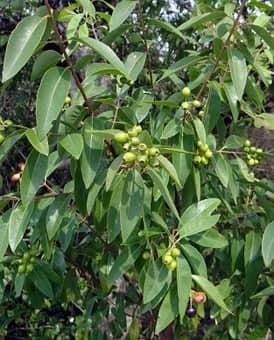Today, you will get information about how many sandalwood trees per acre to plant. As per experts, apply 300 sandalwood trees per acre 600 hosts plants. We guarantee you, that your search for how many sandalwood trees per acre will end here. The host plant list is also available here along with the cultivation details with a very clear explanation of the need, and selection of host plants. Most importantly sandalwood and host plant ratio for a 1-acre plantation is given.
Sandalwood cultivation in India
Well! Before you start planting one of the most expensive trees you should study a little bit about their farming. It has a different farming model due to the existence of host plants in sandalwood farming. If you are not aware of this plant category and want to know what is host plant then don’t worry, information on these plants along with the host plant list is shared in this post.
Information about sandalwood

Sandalwood trees depend on host plants for food. Yes, it is true these trees are not able to occupy nutrients, iron, phosphorus and other nutrition components by themselves from the ground. Instead, they grab food from the root of nearby host plants therefore you need to take more precautions while selecting and planting host plants. It is better to pick host plants that can live for at least 15 to 25 years.
In case you missed it – sandalwood tree profit per acre
However, hostplants with a lifespan of more than 80 to 100 years are more equivalent because sandalwood itself lives more than 100 years. Sandalwood trees need 15 to 20 years to reach maturity level. These trees are used to make furniture, oil, cosmetics, soap and medicines. The heartwood of the sandalwood is precious and owned major market value among other parts of the tree. If you are interested in the “Red Sandalwood Project Report” containing profit per acre with the cost then click the given link.
Host plants for sandalwood trees with correct ratio
Pay more attention to the plantation due to the requirement of host plants. In sandal plantation double host plants are required meaning for one sandal plant 2 host plants are required. Host plants and sandal plants are classified in the following ratio:
1 sandalwood tree: 2 host trees, 1 sandalwood tree: 1 host tree, 2 sandalwood trees :1 host tree. Let’s understand the benefits and disadvantages of picking ample and inadequate host plants.
Read it – 5 most costly trees in India
1 Sandalwood tree: 2 Host trees – This is the best ratio for planting sandalwood and host plants. If you provide 2 host plants for 1 sandalwood plant it will be more beneficial. Through this 1: 2 ratio, a sandalwood plant will get a sufficient amount of required nutrition and if somehow one host plant collapsed or suffers from root rot and is not able to produce sufficient nutrients, in this case, your sandalwood plant will not suffer because of the intake of nutrients from the root of another host plant. So for 1 sandalwood tree, 2 host trees are recommended in “Commercial Sandalwood Cultivation.”
1 Sandalwood tree: 1 Host tree – If you are not able to plant 2 host plants for one sandalwood plant then you can choose the second option. In this ratio, you can plant one host plant for one main plant. This is also good enough for the main plant’s survival, you need to pay a bit more attention and keep checking the condition of your host plant whether it is suffering from any root rot or other diseases. If found any such disease that can result in the collapse of the host plant then immediately arrange a new host plant for your tree.
Read this also – 5 most profitable tree farming in India
2 Sandalwood trees: 1 Host tree – This is the third and final ratio of the host tree plantation. If you are not aware of the plant ratio then you might adopt this ratio which is not recommended. If you don’t have much money and want to start sandalwood cultivation in India then you can practice this ratio in the initial days but later you should move to the above-given ratios for better growth of trees.

Read this – Chandan tree price per kg in India 2023
How many sandalwood trees per acre
- Sandalwood plantation spacing = 400 sandalwood x 400 host plants with 10 feet distance
- Standard plantation = 300 sandalwood plants x 600 host plants
You can choose any one of the plantation frequencies. The first one denotes a 1:1 ratio meaning 1 host plant for one sandalwood plant. Therefore 400 host plants are required for the same number of sandalwood plants per acre. The second one is a standard plantation which is the preferred and recommended plantation. In this plantation method, double host plants are planted for a single sandalwood plant i.e. 2 host plants for 1 sandalwood plant. Therefore 600 host plants are required for 300 sandalwood plants.
Host plant list
A list of host plants for sandalwood is given below:
- Tamarind tree, Jamun tree, Malabar neem tree, Neem tree, Babool tree, Agastya tree, Tur dal (Cajanus cajan)
FAQ
What is the climate required for sandalwood?
This precious tree can survive in various climate conditions, however, planting in freezing winters is a bad practice.
What temperature can sandalwood tolerate?
The temperature should be between 4°C to 45°C.
What climate does Red Sandalwood grow in?
It prefers a dry hot climate with rainfall ranging between 800 mm to 1000 mm per year to thrive better.
How many sandalwood trees per acre should we plant?
300 to 400 sandalwood plants with double host plants or at least the same number of host plants are recommended to plant on 1-acre of land.
How long does sandalwood take to grow?
Sandal tree needs 15 to 20 years to procure sandalwood from the tree.
When can we cut the sandal tree?
Trees may be harvested after attaining a girth of 242 to 3 feet at the above portion of the tree.
How long does the heartwood of sandalwood take to develop?
Sandalwood heartwood starts developing after 7 years.
Which is the best host plant for sandalwood trees?
Tur dal (Cajanus cajan).
Read More
Red sandalwood tree profit per acre